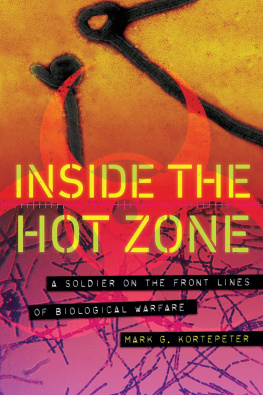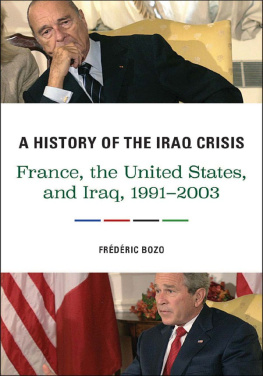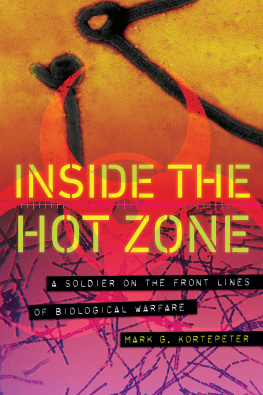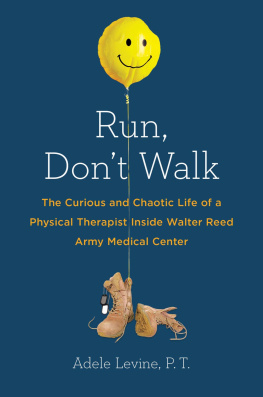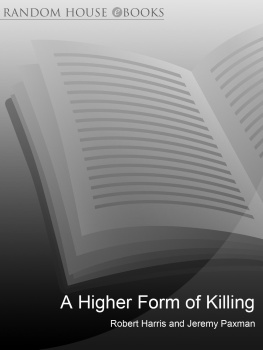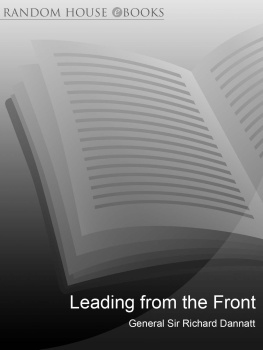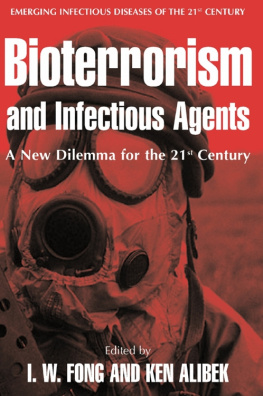Writing in a style reminiscent of The Coming Plague, Kortepeter sheds new light on the horrors of bioweapons, on the inner workings of the federal bureaucracy, and on the insiders views of the anthrax attacks. His expertise and experiences make Inside the Hot Zone compelling reading for anyone interested in scientific, medical, or military thrillers. And, scariest of all, the thrills are real.
Ted Cieslak, MD , Col. (Ret.) U.S. Army, medical co-director of the Nebraska Biocontainment Unit and medical director of the Nebraska Quarantine Unit at the University of Nebraska Medical Center
Absolutely riveting. Dr. Kortepeter tells a fascinating story.... If you want to know what it is to be part of this exceptional team of heroic Americans working in the hot zone, you should read this book.
Lester Martinez-Lopez, MD , MPH , Maj. Gen. (Ret.) U.S. Army, and former commander of the U.S. Army Medical Research and Materiel Command, Fort Detrick, Maryland
Col. Kortepeters inside story from the front lines of our nations defense against the real and increasing threat of biological weapons is fascinating. He gives voice in lucid prose to the unsung heroes working tirelessly at the worlds best biodefense research center at Fort Detrick, Maryland. Their mission is to keep America safe, and our nation owes them an enormous debt of gratitude.
Andy Weber, former assistant secretary of defense for Nuclear, Chemical, and Biological Defense Programs
With extraordinary imagination, a deep knowledge of his subject, and riveting personal accounts of headline-making events in the search for protection against biologic weaponsboth manmade and naturalDr. Mark Kortepeter has written a gripping book.... The novice as well as the most experienced student of biological weapons will emerge from a reading of this book better informed, profoundly grateful for the courage and expertise of these soldiers in the trenches, and surprisingly entertained.
Eric B. Schoomaker, MD , PhD, Lt. Gen. U.S. Army (Ret.), 42nd Army Surgeon General and Commanding General, U.S. Army Medical Command
While Richard Prestons book The Hot Zone very effectively brought the importance of high containment virus work into the living rooms of America, it was heavily sensationalized and far from what actually occurs in a real laboratory. Dr. Kortepeter paints a much more accurate picture as seen from the inside by the staff who do the dangerous work on a daily basis.
Thomas Geisbert, PhD, expert in Ebola and other high containment viruses at the University of Texas Medical Branch, Galveston National Laboratory
Inside the Hot Zone
A Soldier on the Front Lines of Biological Warfare
Mark G. Kortepeter, MD , MPH
Colonel, U.S. Army (Ret.)
Potomac Books
An imprint of the University of Nebraska Press
2020 by Mark G. Kortepeter
Cover designed by University of Nebraska Press; cover image: Electron micrograph of Ebola virus is from the interior. Photomicrograph of Bacillus anthracis courtesy of the CDC Public Health Image Library.
All rights reserved.
Potomac Books is an imprint of the University of Nebraska Press.
Library of Congress Cataloging-in-Publication Data
Names: Kortepeter, Mark, author.
Title: Inside the hot zone: a soldier on the front lines of biological warfare / Mark G. Kortepeter, MD , MPH , Colonel, U.S. Army (Ret.).
Description: Lincoln: Potomac Books, an imprint of the University of Nebraska Press, [2020]
Includes bibliographical references and index.
Identifiers: LCCN 2019016101
ISBN 9781640121423 (cloth: alk. paper)
ISBN 9781640122765 (epub)
ISBN 9781640122772 (mobi)
ISBN 9781640122789 (pdf)
Subjects: LCSH : Kortepeter, Mark. | Biological warfareResearchUnited States. | U.S. Army Medical Research Institute of Infectious Diseases. | BioterrorismPreventionHistory21st century. | PhysiciansUnited StatesBiography.
Classification: LCC UG 447.8 . K 67 2020 | DDC 358/.38dc23 LC record available at https://lccn.loc.gov/2019016101
The publisher does not have any control over and does not assume any responsibility for author or third-party websites or their content.
Dedicated to my parents, Carl Max and Cynthia Kortepeter, and to my uncle and aunt, Paul and Martha Schmidt, who served as my role models for how to live and work.
Be sober-minded; be watchful. Your adversary the devil prowls around like a roaring lion, seeking someone to devour.
1 Peter 5:8 ESV
Without a measureless and perpetual uncertainty, the drama of human life would be destroyed.
Winston Churchill
Contents
Biodefense Solutions to Protect the Nation
USAMRIID motto
In 1998 the army transferred me to USAMRIID [pronounced YOU - SAM - RID ], the U.S. Army Medical Research Institute of Infectious Diseasesthe armys biological weapon defense laboratory. USAMRIID s picturesque setting nestled below the Catoctin Mountains at Fort Detrick, Maryland, belies the important germ-warfare defense work ongoing there since the 1950s Cold War era and continuing today against bioterrorism threats.
When I arrived as a junior public health physician and army major, I had no idea that by the time I left as a colonel, I would be pulled into the maelstrom of numerous nationally significant infectious disease crises. I spent seven and a half years inside USAMRIID , affectionately nicknamed the Hot Zone, after The Hot Zone, Richard Prestons bestseller about the institutes discovery of a new species of Ebola virus. Those seven and a half years would be the most exciting of my twenty-seven-plus years wearing the army uniform.
In 1998 the old guard from the former United States offensive bioweapons program (closed in 1969) had moved on. Our mission was biodefense. It was an amazing time. The vibrant institute was in its heyday in the afterglow of U.S. success in the first Gulf War and held a unique niche as the nations go-to place for all things related to biodefense. In an era of openness, knowledge sharing, and relative innocence, our scientists developed new treatments, vaccines, and diagnostics to thwart potential adversaries like the Soviet Union and Iraq, which might threaten our forces and the nation with deadly infectious pathogens. It was challenging. It was exciting. We were a family. As with any family, we had our differences and scientific disagreements, but we worked through them and took care of one another inside and outside the lab.
Our world changed after the September 11, 2001, terrorist bombings and the anthrax letter attacks that followed. As quickly as the Berlin Wall went up, a tall black fence grew around us, reminiscent of the Cold War behind the fence era of the old offensive biological weapons program. The folksy security guards who watched over our staff late into the night were replaced by a cadre of police armed with pistols, sniper rifles, and 24/7 video monitors. New regulations for enhanced safety and security and nonstop inspections by external agencies bumped science down a notch in priority. In our finest hour, while supporting the nation after the anthrax attacks, our colleagues were targeted as criminal suspects, and one scientist tragically took his own life. Some scientists, frustrated by the constant scrutiny and changing regulations, voted with their feet and left the institute, thus extending USAMRIID s legacy to other burgeoning containment laboratories across the country.
During the period I describe in this book, I moved from the lecture hall to the role of department chief, to the battlefield, to inside the Biosafety Level 4 maximum-containment lab, and finally to the front office. Along the way I played multiple roles as I gained military rank and position: from containing the pathogens and the illnesses they cause, to containing the daily crises, to containing the media explosion and other fallout from crises.

